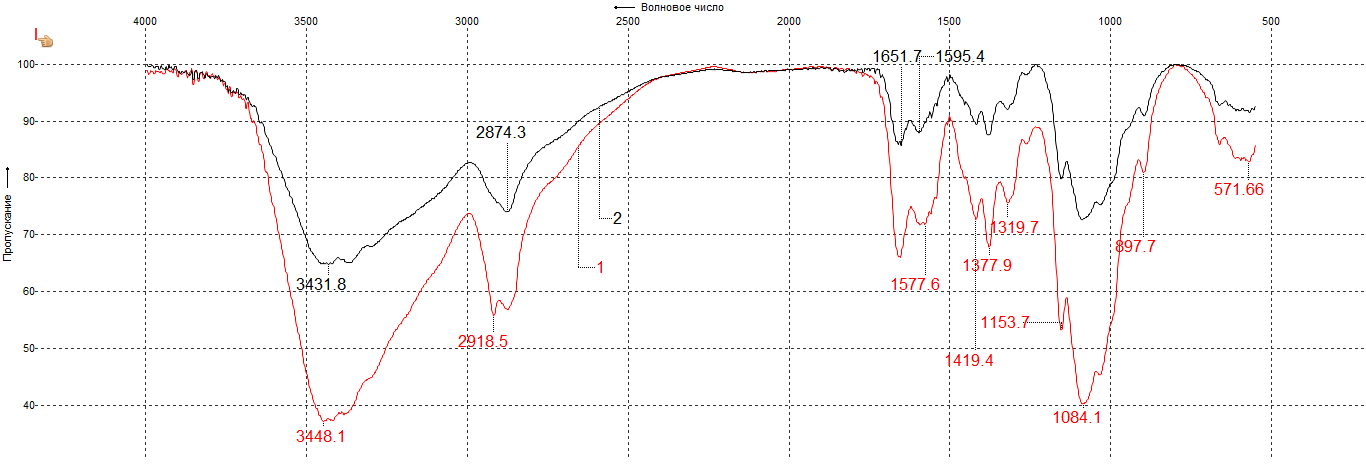CHITOSAN-GLUCAN COMPLEXES OF HIGHEST MUSHROOMS: SELECTION, IDENTIFICATION AND DETER-MINATION OF SOME PROPERTIES
Abstract
The work is devoted to the study of chitosan-glucan complexes obtained from the higher fungi of the autumnal marmot (Armillaria mellea), shiitake (Lentinula edodes) and grifola frutosa (Grifola frondosa), optimization of the method of isolation and expansion of their use for various areas of the national economy. As objects of research, strains of fungi L. edodes F-1000 and G. frondosa 2639 isolated from commercial mycelium and A. mellea D-13 strain isolated from fruiting bodies harvested from Betula pendula stems in natural habitats of the Altai Territory. When analyzing the IR spectroscopy data, it was established that the samples of chitosan-glucan complexes isolated from the fruiting bodies of fungi are identical to the structure of chitosan obtained in the traditional way from the king crab (Paralithodes camtschaticus). It was found that the test chitosan-glucan complexes in terms of intrinsic viscosity (1.6–2.2 cm3/g), molecular weight (37.5–51.8 kDa) and deacetylation degree (75.6–79.5%) significantly exceed the chitosan-glucan complexes obtained from the oyster mushroom (Pleurotus osteratus) and are comparable to the chitosan-glucan complexes of mold fungi (Aspergillus niger). At the same time, the chitosan-glucan complexes from A. mellea D-13 are closest to the chitosan isolated from P. camtschaticus in the above indices. According to the physico-chemical properties, the investigated chitosan-glucan complexes correspond to the requirements of food chitosan (TU 9289-067-00472124).
Downloads
Metrics
References
Younes I., Rinaudo M. Mar Drugs., 2015, vol. 13(3), pp. 1133–1174. DOI: 10.3390/md13031133.
Muzzarelli R.A., Muzzarelli С. Adv. Polyni. Sci., 2004, vol. 186, pp. 151–209. DOI: 10.1007/b136820.
Crestini C., Kovac B., Giovannozzi-Sermanni G. Biotechnology and Bioengineering, 1996, vol. 50, pp. 207–210. DOI: 10.1002/bit.260500202.
Skryabin K.G., Vikhrevoy G.A., Varlamova V.P. Khitin i khitozan: polucheniye, svoystva i primeneniye. [Chitin and chitosan: preparation, properties and application], Moscow, 2002, 368 p. (in Russ.).
Loginova N.V., Smirnova L.A., Chernorukov N.G. Vestnik Nizhegorodskogo universiteta im. N.I. Lobachevskogo. [Bulletin of Nizhny Novgorod University N.I. Lobachevsky], 1998, no. 1, pp. 128–131. (in Russ.).
Nwe N., Chandrkrachang S., Stevens W.F., Maw T.T.T.K., Khor E., Wong S.M. Carbohydrate Polymers, 2002, vol. 49, pp. 235–237. DOI: 10.1007/s11274-008-9755-x.
Nwe N., Stevens W.F. Biotechnology Letters, 2002, vol. 24, pp. 1461–1464. DOI: 10.1023/A:1019898715518.
Kurita K. Polym. Degrade. Stabil., 1998, vol. 59, pp. 117–120.
Nwe N., Furuike T., Tamura H. Adv. Polym. Sci., 2011, vol. 244, pp. 187–208. DOI: 10.1007/12_2011_124.
Minakov D.V., Sevodina K.V., Shadrintseva A.I., Sevodin V.P. Izvestiya vuzov. Prikladnaya khimiya i biotekhnologi-ya, 2016, vol. 6, no. 4, pp. 46–52. DOI: 10.21285/2227-2925-2016-6-4-46-52 (in Russ.).
Minakov D.V., Sevodina K.V., Shadrintseva A.I., Sevodin V.P. Izvestiya vuzov. Prikladnaya khimiya i biotekhnologi-ya, 2016, vol. 6, no. 3, pp. 50–56. DOI: 10.21285/2227-2925-2016-6-3-50-56 (in Russ.).
Minakov D.V., Sevodina K.V., Shadrintseva A.I., Sevodin V.P. Tekhnika i tekhnologiya pishchevykh proizvodstv, 2017, no. 1 (44), pp. 24–30. (in Russ.).
Hansen L., Knudsen H. Nordic Macromycetes. Vol. 3: heterobasidioid, aphyllophoroid and gastromycetoid Basidio-mycetes, Copenhagen, 1997, 445 p.
Bukhalo A.S. Vysshiye s’yedobnyye bazidiomitsety v chistoy kul’ture. [Highest edible basidiomycetes in pure culture], Kiev, 1988, 144 p. (in Russ.).
Bukhalo A.S. Kul’tivirovaniye s’yedobnykh i lekarstvennykh gribov. Prakticheskiye rekomendatsii. [Cultivation of edi-ble and medicinal mushrooms. Practical recommendations], Kiev, 2004, 128 p. (in Russ.).
Patent 4282351 (US). 1981.
Kuchina Yu.A., Dolgopyatova N.V., Novikov V.Yu. Vestnik MGTU, 2012, vol. 15, no. 1, pp. 107–113. (in Russ.).
Mistry B.D. Handbook of spectroscopic data: chemistry. (UV, IR, PMR, 13CNMR and mass spectroscopy), Jaipur, 2009, 242 p.
Tharanathan N.R., Kittur S.F. Crit. Rev. Food Sci., 2003, vol. 43, pp. 61–87. DOI: 10.1080/10408690390826455.
Herrera J.R. Fungal glucans // In: Fungal cell wall: Structure, Synthesis, and Assembly, 1991, vol. 1, pp. 59–88.
Unrod V.P., Lega Yu.G., Solodovnik T.V. Novyye dostizheniya v issledovanii khitina i khitozana [New advances in the study of chitin and chitosan], Moscow, 2001, pp. 58–61.
Muzzarelli R.A.A., Tanfani F., Scarpini G. Biotechnology and Bioengineering, 1980, vol. 22, pp. 885–896.
Berecochea-Lopez A., Decorde K., Ventura E., Godard M., Bornet A., Teissedre P.L., Cristol J.P., Rouane J.M. J. Agric. Food Chem., 2009, vol. 57, pp. 1093–1098. DOI: 10.1021/jf803063v.


This work is licensed under a Creative Commons Attribution 4.0 International License.
The authors, which are published in this journal, agree to the following conditions:
1. Authors retain the copyright to the work and transfer to the journal the right of the first publication along with the work, at the same time licensing it under the terms of the Creative Commons Attribution License, which allows others to distribute this work with the obligatory indication of the authorship of this work and a link to the original publication in this journal .
2. The authors retain the right to enter into separate, additional contractual agreements for the non-exclusive distribution of the version of the work published by this journal (for example, to place it in the university depository or to publish it in a book), with reference to the original publication in this journal.
3. Authors are allowed to post their work on the Internet (for example, in a university repository or on their personal website) before and during the review process of this journal, as this may lead to a productive discussion, as well as more links to this published work.











